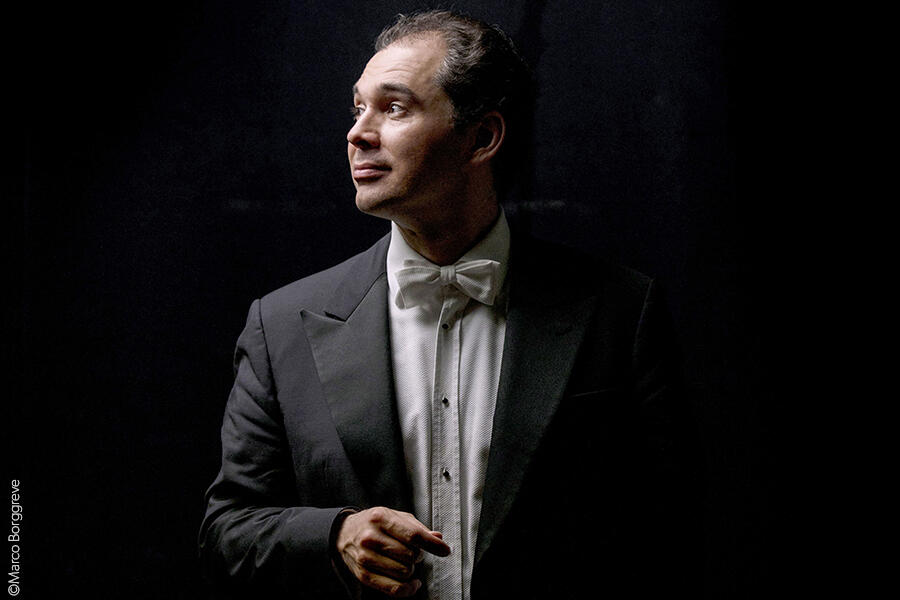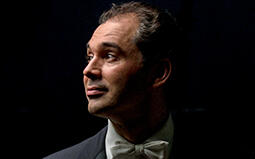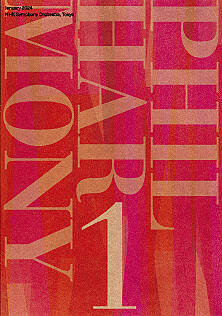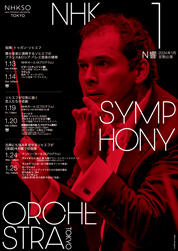- Home
- Concerts
- Subscription Concerts 2023-2024
- Program A
- No. 2001 Subscription (Program A)
No. 2001 Subscription (Program A)
NHK Hall
Google Map Seating Chart

Program
Bizet / Shchedrin / Carmen Suite, ballet
Throughout music history abundant in episodes of successful youths, late-bloomer composers are not so many, much less those who received a high evaluation only after their death. The French Romantic Bizet is one such example: he was relatively neglected during his life and died suddenly at age 36, without seeing the howling triumph of his opera Carmen (1875) which was premiered three months earlier in Paris.
Set in Seville, Spain, the French opera Carmen has all the keys for sell-out performances in opera houses: fascinating exoticism, unforgettable melodies, an ill-fated triangle around the fearless, mercurial gypsy heroine. The sensational plot – the title-role, a prison escapee now in love with a star bullfighter, gets stabbed by her jealous ex-lover Don José – paved the way for the coming realistic operas.
Among countless suites and arrangements of this hit, the one by the Soviet and Russian composer Shchedrin is by far the most original. It is, rather than a common opera suite, an inspired and free re-creation which is playful but deeply respectful toward Bizet. Shchedrin prepared it as a ballet score for his wife Maya Plisetskaya, a legendary prima ballerina. She played the role of Carmen at the 1967 premiere at Moscow’s Bolshoi Theatre with the libretto and choreography by the Cuban dancer Alberto Alonso. The unique, modern sound is very likely related to Alonso’s origin, as it is scored for strings – excluding the winds – and a large battery of percussion containing Latin instruments (bongos, guiro, maracas, claves).
Composed of thirteen numbers, Carmen Suite opens (and concludes) with chimes resounding fragments of Carmen’s provocative aria Habanera while the opera’s popular prelude (to Act 1) is heard during XIII Finale. The most humorous would be IX Torero where Shchedrin repeatedly spares the celebrated refrain of the Treador Song against our expectations. Besides the numbers from Carmen, VIII Bolero is based on Farandole from Bizet’s incidental music to L’Arlésienne (The Girl from Arles) and X Torero and Carmen is Bohemian Dance from Bizet’s opera La jolie fille de Perth (The Fair Maid of Perth).
[Kumiko Nishi]
Ravel / Ma mère l’Oye, suite (Mother Goose)
The charming house that the French composer Ravel spent his last sixteen years in is known for having brimmed with toys and curiosities he collected. Fascinated by the poetry of childhood through life, he penned the opera L’enfant et les sortilèges (The Child and the Spells) and his suite Ma mère l’Oye (Mother Goose) is certainly in the same vein. A lifelong bachelor, the composer originally completed the suite as a piano duet in 1910 for the daughter and son of his best friends, a couple. He used to enjoy reading stories to the young siblings, which motivated him to compose this work based on fairytales as told by French authors including Charles Perrault (1628–1703). Ravel then made from it the orchestral suite and the ballet score in 1911.
The orchestral suite attests his renowned, perfectly judged instrumentation. I Pavane de la belle au bois dormant (Pavane of Sleeping Beauty), a brief antique dance, precedes II Petit poucet (Little Thumb) where frequent meter changes illustrate the tiny hero’s wandering. III Laideronnette, impératrice des Pagodes (Little Ugly Girl, Empress of the Pagodas) sounds oriental due to the utilization of pentatonic (five-note) scales and tam-tam (gong). IV Les entretiens de la belle et de la bête (Conversation of Beauty and the Beast) entrusts Beauty to an elegant clarinet solo and the Beast to an uncouth contrabassoon solo. V Le jardin féerique (The Fairy Garden) has a shimmeringly luxuriant denouement livened up by triangle, celesta, keyboard glockenspiel and harp.
[Kumiko Nishi]
Ravel / La valse, ballet
Ravel paid tribute to Franz Schubert (1797–1828), writing eight waltzes for the Valses nobles et sentimentales (1911). Five years earlier, actually, Ravel had the idea of composing a new piece to pay his respects to another Austrian master Johann Strauss II (1825–1899) a.k.a. “The Waltz King”. This homage to the 19th-century Viennese waltz – that Ravel would name straightforwardly La valse (The Waltz) – began to take shape as a ballet score in 1919 as a commission from Sergei Diaghilev for his dance company, Ballets Russes.
Hearing what Ravel completed, the Russian impresario turned it down commenting that it was “not a ballet” but “a portrait of ballet.” Instead of discarding it, Ravel premiered the version for two pianos in 1920 before the version subtitled “a choreographic poem for orchestra” was revealed the same year: up until then, the Viennese waltz became a thing of bygone days that the world could never return to after having lived through World War I. This background is often associated with La valse’s ominous conclusion where the rhythm of waltz, now uncontrollable, leads itself to destruction.
According to Ravel, La valse is “set in an imperial court, around 1855” and begins as follows: “Through rents in swirling clouds, couples are glimpsed waltzing. The clouds disperse little by little: one sees an immense hall peppered with a whirling crowd. The scene is gradually illuminated. The light of the chandeliers bursts forth at fortissimo.”
[Kumiko Nishi]
Artists
 ConductorTugan Sokhiev
ConductorTugan Sokhiev
Born in Vladikavkaz in North Ossetia of the former Soviet Union in 1977, Tugan Sokhiev studied conducting under the legendary tutors Ilya Musin and then Yuri Temirkanov at the St. Petersburg Conservatory. Since 2008, as Music Director of the Orchestre national du Capitole de Toulouse, he has contributed to the development of the orchestra, at the same time, served as Principal Conductor of the Deutsches Symphonie-Orchester Berlin from 2012 to 2016. Furthermore, from 2014, he served as Music Director of the Bolshoi Theatre in Moscow, while making guest appearances with prestigious orchestras and at opera houses, including the Wiener Philharmoniker, the Berliner Philharmoniker and the Royal Concertgebouw Orchestra, thus has actively worked internationally in concerts and operas. In 2022, grieved by the invasion of Ukraine by Russia, his beloved homeland, he resigned from his posts at both the Bolshoi Theatre and the Orchestre national du Capitole de Toulouse, however, even after that he has continued to be in full demand from all over the world. He has been highly evaluated for his accurate sense of style and rich interpretations such as the dynamic scale he introduces to perform Russian works, the sophisticated sense he employs to French repertoire and his full expression in an orthodox approach towards German works. He has returned to the NHK Symphony Orchestra almost every year to present delightful performances. On this visit, he will surely demonstrate his diversity in expression through three programs of French, German and Russian works.
[Motoyuki Teranishi, music critic]
Download
Ticket
Program A
No. 2001 Subscription (Program A)
NHK Hall
Google Map
Seating Chart
Single Tickets Release Date
Pre-sales for Subscribers:Thursday, October 26, 2023
*about subscribers
Sale to General Public:Sunday, October 29, 2023
Price
| S | A | B | C | D | E | |
|---|---|---|---|---|---|---|
| Ordinary Ticket | 9,100 | 7,600 | 5,900 | 4,800 | 3,800 | 2,000 |
| Youth Ticket | 4,000 | 3,500 | 2,800 | 2,100 | 1,500 | 1,000 |
Seating chart Enlarge Print PDF
*tax included
*Subscribers receive a 10% discount (Available at NHKSO WEB Ticket and N-Kyo Guide)
*For wheelchair-accessible seats, please refer to the N-Kyo Guide
Youth Tickets
Youth Tickets are great options for those of 25 years old and younger
Subscription tickets
Release Date
ANNUAL SUBSCRIPTION TICKETS
Mon., July 17, 2023 10:00am
[For Subscribers: Sun., July 9, 2023 10:00am]
SEASONAL SUBSCRIPTION TICKETS (WINTER)
Tue., Oct. 17, 2023 10:00am
[For Subscribers: Thu., Oct. 12, 2023 10:00am]
Where to buy
NHKSO WEB Ticket | Saturday, January 13 (In English / Seats not selectable)
NHKSO WEB Ticket | Sunday, January 14 (In English / Seats not selectable)
NHKSO WEB Ticket (In Japanese only / Seats selectable)
N-Kyo Guide (Purchase by telephone only)
Other Ticket Agents
Broadcast
 NHK-FMNo. 2001 Subscription (Program A)
NHK-FMNo. 2001 Subscription (Program A)
Thursday, Jan 18, 2024 7:30PM - 9:10PM
Program:
Bizet / Shchedrin / Carmen Suite, ballet
Ravel / Ma mère l’Oye, suite (Mother Goose)
Ravel / La valse, ballet
Conductor:Tugan Sokhiev
Recorded:January 13, 2024 NHK Hall
*Repertoire, conductor, soloists and program order are subject to change without notice.
*Pre-school children are not allowed in the concert hall



